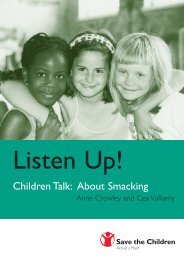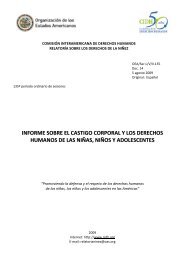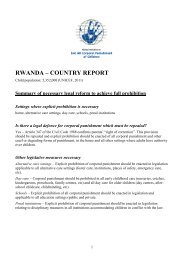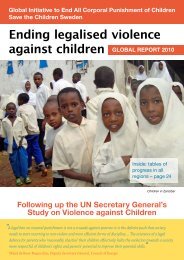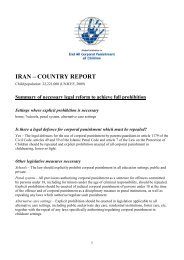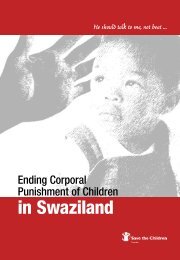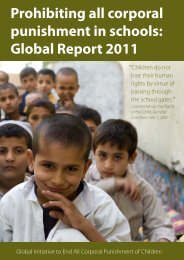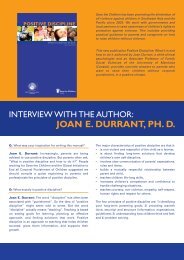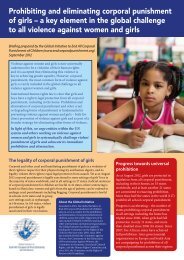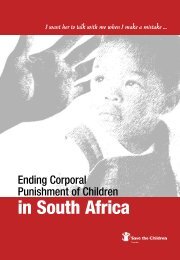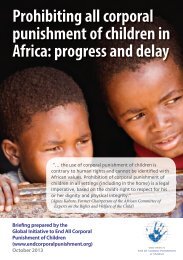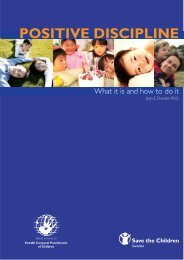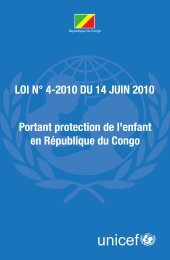eliminating corporal punishment: a human - Global Initiative to End ...
eliminating corporal punishment: a human - Global Initiative to End ...
eliminating corporal punishment: a human - Global Initiative to End ...
You also want an ePaper? Increase the reach of your titles
YUMPU automatically turns print PDFs into web optimized ePapers that Google loves.
THE NATURE AND EXTENT OF<br />
CORPORAL PUNISHMENT –<br />
PREVALENCE AND ATTITUDINAL<br />
RESEARCH IN NORTH AMERICA<br />
Summaries prepared by the <strong>Global</strong> <strong>Initiative</strong> <strong>to</strong> <strong>End</strong><br />
All Corporal Punishment of Children<br />
(www.end<strong>corporal</strong><strong>punishment</strong>.org), March 2008<br />
CANADA<br />
In a sample of mothers of preschoolers in Mani<strong>to</strong>ba, 59% reported having used physical <strong>punishment</strong> in<br />
the previous two weeks.<br />
(Ateah, C. & Durrant, J. E., 2005, “Maternal use of physical <strong>punishment</strong> in response <strong>to</strong> child misbehavior: Implications for<br />
child abuse prevention”, Child Abuse & Neglect, 29, pp.177-193)<br />
A survey of 1,000 people in an SES/Sun Media poll in January 2004 found that 64% support the use of<br />
force such as spanking by parents <strong>to</strong> discipline a child, though a wide majority oppose physical force<br />
being used by others. Support for spanking as a reasonable measure was highest in the West at 71%<br />
and Ontario at 62%. The lowest support was Quebec at 47%. Only 7% supported criminal charges for<br />
parents who spank their children; 7% also said that children should be removed from homes where<br />
their parents used spanking as <strong>corporal</strong> <strong>punishment</strong>; 5% supported both these measures.<br />
(“Spanking poll backs ruling”, Winnipeg Sun, Mani<strong>to</strong>ba, 1 February 2004)<br />
In a sample of mothers of preschoolers in Mani<strong>to</strong>ba and Ontario, 70% reported having used physical<br />
<strong>punishment</strong> at some time; one-third of those who used it did so at least once per week.<br />
(Durrant, J. E., Rose-Krasnor, L. & Broberg, A., 2003, “Maternal beliefs about physical <strong>punishment</strong> in Sweden and<br />
Canada”, Journal of Comparative Family Studies, 34, pp.586-604)<br />
A national postal survey of households with children under the age of 6, completed by 1,643 parents<br />
(698 married mothers, 698 married fathers and 247 single mothers), was carried out in 1998-1999.<br />
Overall, 51% of parents reported using physical <strong>punishment</strong> occasionally or more often (1%<br />
“frequent”, 39% “rarely”, 11% “sometimes”); 49% reported never using it. There was no difference<br />
between mothers and fathers in the use of <strong>corporal</strong> <strong>punishment</strong>, but single mothers were less likely <strong>to</strong><br />
use it than married parents, and parents with low education were more likely <strong>to</strong> use it than those with<br />
high levels of education. It was more often used for children aged 1-5 years, but 40% of parents of<br />
infants under the age of one year reported using physical <strong>punishment</strong> on their babies.<br />
(Oldershaw, L., 2002, A national survey of parents of young children, Toron<strong>to</strong>: Invest in Kids Foundation)<br />
A 2002 survey found that 50% of parents reported that they or their spouse had “inflicted light<br />
<strong>corporal</strong> <strong>punishment</strong>, like a slap” on their children; 6% reported that they or their spouse had “inflicted<br />
painful <strong>corporal</strong> <strong>punishment</strong>”.<br />
(Canadian Press and Leger Marketing, 2002, Child Abuse Report, Montreal, PQ: Canadian Press and Leger Marketing)<br />
1
In a 2001 survey, 10% of parents reported that they use physical <strong>punishment</strong> when their children break<br />
the rules.<br />
(Berger, E., 2001, National Report on Inter-Generation Abuse, Toron<strong>to</strong>, ON: Berger Population Health Moni<strong>to</strong>r)<br />
In a 2000 survey of university students in British Columbia and Mani<strong>to</strong>ba, 75% reported having<br />
experienced parental physical <strong>punishment</strong> as children or adolescents. Of these, 37% reported being<br />
slapped on the head, 34% being hit with an object, and 18% being whipped.<br />
(Ateah, C. & Parkin, C. M., 2002, “Childhood experiences with and current attitudes <strong>to</strong>ward <strong>corporal</strong> <strong>punishment</strong>”,<br />
Canadian Journal of Community Mental Health, 21, pp.35-46)<br />
In a 1999 survey of Quebec mothers, 48% reported having physically punished their children in the 12<br />
previous months by pinching, shaking or hitting the child on the but<strong>to</strong>cks. Acts of severe violence such<br />
as shaking an infant, hitting a child on the face or head, punching, kicking or slapping, or hitting with<br />
an object within the previous 12 months were reported by 7% of mothers in the sample.<br />
(Clément, M. E. et al., 2000, La violence familiale dans la vie des enfants du Québec, Québec, PQ: Institut de la Statistique<br />
du Québec)<br />
In the 1998 Canadian Incidence Study of Reported Child Abuse and Neglect, 69% of substantiated<br />
physical abuse incidents were identified as cases of physical <strong>punishment</strong>.<br />
(Trocmé, N. et al., 2001, Canadian Incidence Study of Reported Child Abuse and Neglect, Ottawa, ON: National<br />
Clearinghouse on Family Violence)<br />
In 1992, surveys on attitudes <strong>to</strong>wards smacking were carried out in Toron<strong>to</strong> and Winnipeg. In the<br />
Toron<strong>to</strong> Area Survey, an annual survey carried out by the Institute for Social Research at York<br />
University, only one out of 229 respondents aged 18 years and over felt that physical discipline is<br />
never appropriate. In the Winnipeg Area Survey, an annual survey conducted by the Department of<br />
Sociology at the University of Mani<strong>to</strong>ba, 30.4% of the 528 respondents aged 18 years and over were in<br />
favour of a law banning smacking, though if it were shown that the Swedish law had reduced injuries<br />
<strong>to</strong> children, this figure increased <strong>to</strong> 65.4%. About 25% felt that <strong>corporal</strong> <strong>punishment</strong> was never<br />
acceptable.<br />
(Durrant, J., 1996, “Public attitudes <strong>to</strong>ward <strong>corporal</strong> <strong>punishment</strong> in Canada”, in Frehsee, D., Horn, W. & Bussmann, K-D.,<br />
eds, 1996, Family Violence Against Children, New York: Walter de Gruyter, pp.107-118)<br />
In a sample of Ontario parents, 85% reported having slapped or spanked their children and 20%<br />
reported having hit their children with objects.<br />
(Len<strong>to</strong>n, R. L., 1990, “Techniques of child discipline and abuse by parents”, Canadian Review of Sociology &<br />
Anthropology, 27, pp. 157-184)<br />
In a 1988 survey, 21% of parents reported that they use physical <strong>punishment</strong> (19% occasionally, 2%<br />
often or very often).<br />
(Decima Research Inc., 1988, Report <strong>to</strong> the Institute for the Prevention of Child Abuse on a nation-wide survey of attitudes<br />
<strong>to</strong>ward child rearing, Toron<strong>to</strong>, ON: Decima Research Inc.)<br />
2
UNITED STATES OF AMERICA<br />
A telephone interview survey of 600 adults in each of the 50 states, carried out by SurveyUSA of<br />
Verona NJ in August 2005, found that overall almost three out of four (72%) supported the use of<br />
spanking as a disciplinary method (ranging from 55% in Vermont <strong>to</strong> 87% in Alabama), with almost<br />
one in four (23%) believing it acceptable for a teacher <strong>to</strong> spank a child (ranging from 8% in New<br />
Hampshire <strong>to</strong> 53% in Arkansas and Mississippi). Nearly one third (31%) believed it is acceptable <strong>to</strong><br />
wash out a child’s mouth with soap (from 23% in Hawaii, Maryland and Massachusetts <strong>to</strong> 46% in<br />
Idaho).<br />
(SurveyUSA, Verona NJ, August 2005, Disciplining a Child 08/24/05,<br />
www.surveyusa.com/50StateDisciplineChild0805SortedbyTeacher.htm)<br />
Federal statistics show that during the 2002-3 school year, more than 300,000 American<br />
schoolchildren were disciplined with <strong>corporal</strong> <strong>punishment</strong>, usually one or more blows with a thick<br />
wooden paddle. Sometimes holes were cut in the paddle <strong>to</strong> make the beating more painful. Of those<br />
students, 70% were in five Southern states: Texas, Mississippi, Tennessee, Alabama and Arkansas.<br />
(Reported in New York Times, 30 September 2006)<br />
An ABC News telephone poll of a random national sample of 1,015 adults in 2002 found that overall<br />
65% approved of spanking children, with 31% disapproving; 72% thought that teachers should not be<br />
permitted <strong>to</strong> spank children in school.<br />
(ABC News poll conducted by telephone, 25-29 Oc<strong>to</strong>ber 2002; fieldwork by International Communications Research of<br />
Media, Pennsylvania)<br />
Official data on <strong>corporal</strong> <strong>punishment</strong> in US public schools for the 1999-2000 school year, released in<br />
February 2003 (and as at July 2005 the most recent available), reported that overall 342,038 students<br />
were subjected <strong>to</strong> <strong>corporal</strong> <strong>punishment</strong>. This is a drop of 7% from the previous survey two years earlier<br />
(taking enrolment increases in<strong>to</strong> account), and continues a steady trend. Total US public school<br />
enrolment in 1999-2000 was 46,306,355. According <strong>to</strong> data for the 23 states which have not prohibited<br />
all <strong>corporal</strong> <strong>punishment</strong> in public schools, the highest rates for school <strong>corporal</strong> <strong>punishment</strong> were in<br />
Mississippi (48,627 or 9.8% of students), Arkansas (40,437 or 9.1% of students), Alabama (39,197 or<br />
5.4% of students), and Tennessee (38,373 or 4.2% of students). Black students were hit at a rate more<br />
than twice their proportion in the population: they comprised 17% of students, but suffered 39% of<br />
paddlings; white students made up 62% of all students, but suffered 53% of the <strong>corporal</strong> <strong>punishment</strong>.<br />
(US Department of Education, Office for Civil Rights, 2000 Elementary and Secondary School Civil Rights Compliance<br />
Report, analysis from the Center for Effective Discipline, www.s<strong>to</strong>phitting.com)<br />
A nationally representative sample of 991 American parents, interviewed in the mid-1990s, examined<br />
six types of <strong>corporal</strong> <strong>punishment</strong>: slaps on the hand or leg, spanking on the but<strong>to</strong>cks, pinching,<br />
shaking, hitting on the but<strong>to</strong>cks with a belt or paddle and slapping in the face. The study found that the<br />
overall percentage of parents using any of these types of <strong>corporal</strong> <strong>punishment</strong> during the previous year<br />
was 35% for infants and reached a peak of 94% at ages 3 and 4 years. Despite a rapid decline in use<br />
after the age of 5 years, just over half of American parents hit children at age 12 years, a third at age 14<br />
years, and 13% at age 17 years. Further analysis found that parents who hit teenage children did so on<br />
average about six times during the year. Severity, as measured by hitting the child with a belt or<br />
paddle, was greatest for children aged 5–12 years (28% of such children).<br />
(Straus, M. A. & Stewart, J. H., 1999, “Corporal Punishment by American Parents: National Data on Prevalence,<br />
Chronicity, Severity, and Duration, in Relation <strong>to</strong> Child and Family Characteristics”, Clinical Child and Family Psychology<br />
Review, vol. 2, no. 2, pp.55-70)<br />
3
A review of the research literature on child abuse in daycare settings, with an emphasis on identifying<br />
variables associated with victims, perpetra<strong>to</strong>rs and settings, found that physical abuse in daycare<br />
centres and homes most frequently occurred in the context of “disciplining” the child, and may have<br />
been supported by parental permission for <strong>corporal</strong> <strong>punishment</strong>.<br />
(Schumacher, R.B. & Carlson, R.S., 1999, “Variables and risk fac<strong>to</strong>rs associated with child abuse in daycare settings”,<br />
Child Abuse & Neglect, vol. 23, no. 9, pp.891-898)<br />
A 1995 survey in America found that 49% of parents admitted <strong>to</strong> disciplining their children by hitting<br />
the child with an object other than on the but<strong>to</strong>cks, kicking the child, beating the child, and threatening<br />
the child with a gun.<br />
(Straus, M. A. et al., 1998, “Identification of child maltreatment with the Parent-Child Conflict Tactics Scales: development<br />
and psychometric data for a national sample of American parents”, Child Abuse & Neglect, vol. 22, pp.249-270. Cited in<br />
Krug, E. G. et al., eds, 2002, World report on violence and health, Geneva: World Health Organisation, p.62)<br />
Other research has found that over 90% of <strong>to</strong>ddlers are spanked or subjected <strong>to</strong> other forms of <strong>corporal</strong><br />
<strong>punishment</strong>, and almost 50% of adults recall receiving <strong>corporal</strong> <strong>punishment</strong> as children.<br />
(Straus, M. A. & Kan<strong>to</strong>r, G. K., 1994, “Corporal <strong>punishment</strong> of adolescents by parents: A risk fac<strong>to</strong>r in the epidemiology of<br />
depression, suicide, alcohol abuse, child abuse, and wife beating”, Adolescence, vol. 29, pp.543-561. Cited in Youssef, M.<br />
S.-E.-D. A. & Kamel, M. I., 1998, “Children experiencing violence I: Parental use of <strong>corporal</strong> <strong>punishment</strong>”, Child Abuse<br />
and Neglect, vol. 22, no. 10, p.960)<br />
In a survey of American primary care physicians, 67% supported physical <strong>punishment</strong>, with younger<br />
physicians more likely <strong>to</strong> support <strong>corporal</strong> <strong>punishment</strong> (63% aged over 40, 72% under 40).<br />
(McCormick, K. F., 1992, “Attitudes of primary care physicians and pediatricians <strong>to</strong>wards <strong>corporal</strong> <strong>punishment</strong>”, Journal<br />
of the American Medical Association, vol. 267, pp.3161-3165. Cited in Hesketh, T., Hong, Z. S. & Lynch, M. A., 2000,<br />
“Child abuse in China: the views and experiences of child health professionals”, Child Abuse & Neglect, vol. 24, no. 6,<br />
pp.867-872)<br />
4



